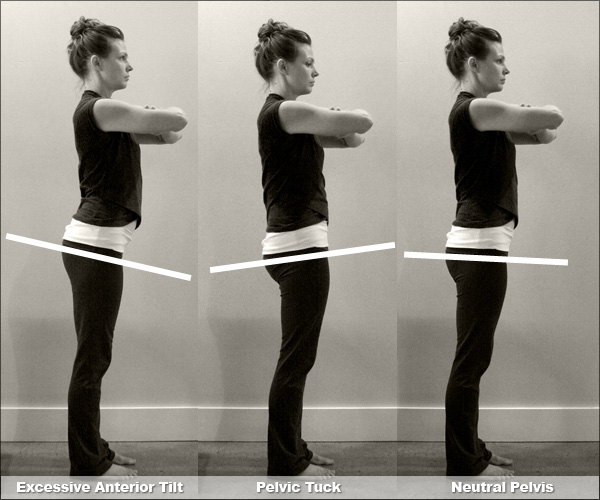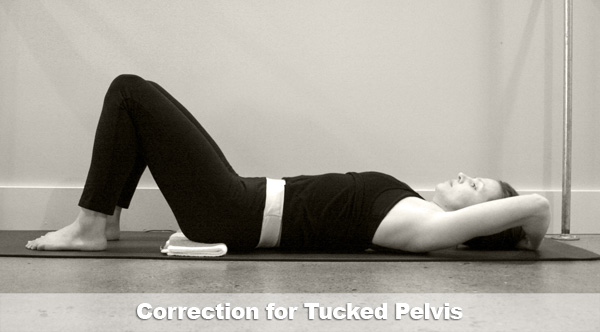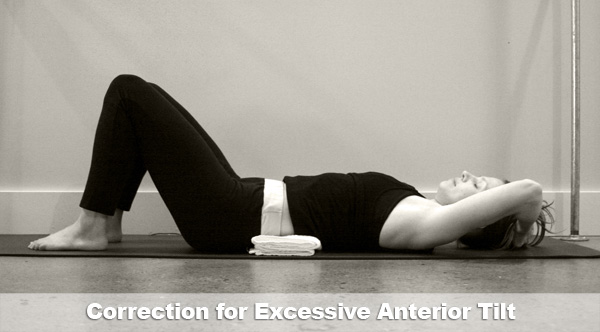
In the last post we learned that tucking the pelvis during exercise can have negative affects and it's not the best way to strengthen your body or lengthen your spine. In this article we’ll look at the antidote to a tucked pelvis: the neutral pelvis.
Our spine has three curves in it: One in the low back called the lumbar curve; one in the upper to mid-back called the thoracic curve; and a curve in our neck called the cervical curve. These curves influence one another. If something is off balance in one, the other two will also be out of balance.
Since the spine rests on the pelvis, the curves of the spine are also influenced by the position of the pelvis.
Arching Your Back Too Much (Excessive Anterior Tilt)
If the top of the pelvis is tilted forward (anterior tilt) the lumbar curve will be deepened—it’s more commonly called “arching your back.” This also causes the other curves of the spine to deepen in response. When this happens, the individual vertebrae (bones that make up the spine) won't be able to align with one another.
Excessive anterior tilt (arching) creates stress where the pelvis and spine meet (the lumbosacral joint) as well as stress in other joints of the spine. The top of the pelvis tilting forward also increases the stress on the hip joint.
If the top of the pelvis is tilted back (tucked) the curve of the lower back is flattened. Since the curves of the spine are the body’s natural shock absorbers, when they are flattened, it limits the spine’s ability to absorb the forces it meets throughout daily life. Additionally, the flexibility of the hip joint is reduced and can decrease your overall mobility.
Learning how the ideal alignment for your pelvis looks, and especially how it feels, can profoundly effect the health of your spine and health in general.
What Is a Neutral Pelvis Anyway?
If you've ever taken a Pilates class, you've probably heard the term “neutral pelvis.”
When I first started taking Pilates in 2001, I heard the term all the time. I never understood what the teacher was talking about, but I could tell from the tone of her voice that it was likely something important I needed to know.
It wasn't until I started Pilates teacher-training in 2004 that I finally understood what neutral pelvis was actually all about, and it turns out… I didn't have one. My pelvis was, pretty much, permanently locked in a tucked state.
So what is a neutral pelvis? The technical description of a neutral pelvis goes like this: When your ASIS (anterior superior iliac spine—the bony landmarks on the front of your hip bones) and your pubic bone are on the same level, or same plane, your pelvis is in a neutral position in relation to your spine.

Because I had become accustomed to the feeling of a flattened out lumbar curve (a tucked pelvis) when I first began working or standing with my pelvis in a more neutral position, it felt really unnatural. I felt like I was arching my lower back and sticking out my rear end. I had a difficult time finding the neutral position and it was frustrating!
Now I know that when the body is used to holding itself in a particular pattern, such as a tucked pelvis, you can't just put it in its ideal alignment once or twice and expect it to take hold for good.
First you have to unlearn the old pattern by developing a new awareness. Second, you have to re-enforce the newly learned physical pattern with supportive movement, using imagery and teaching the body what the desired alignment feels like over time.
You Gotta’ Move It, Move It
A neutrally aligned pelvis allows the curves of the spine to operate in a balanced state with one another. This allows your spine to absorb the impact of the forces our bodies meet throughout our daily activities. But it's not a position you want to stay fixed in constantly, or muscularly force yourself into.
The pelvis is comprised of three bones and each has its own, individual moving rhythm. Don’t think of the pelvis as fixed, or a single solid structure.
A neutral pelvic position is one you want to be able to find in your body and then, “…move from it, thru it and back to it.” (Marie Jose Blom). And this is not meant to be a fixed state, but more like a dance that your pelvis moves through as you your body adapts and moves.
Learning how to naturally maintain a neutral pelvis allows you to physically move through each day with fluidity and ease.
Locked Neutral Pelvis: Also Not Good
You can run into just as much trouble overcompensating to create a neutral pelvis as you can tucking your pelvis. Tipping the pelvis too far forward in an attempt to create a neutral position puts a strain on the lower back and makes it difficult to engage the deepest core muscles.
Forcing the pelvis into neutral and trying to make it stay there creates problems too. Sometimes people try to maintain what they think is a neutral pelvis while rolling up or lifting the head, neck and shoulders off the mat and they end up straining their backs. This is not good!
Some have confused the concept of a neutral pelvis with maintaining a small amount of space under the low back. Trying to keep space under the low back at any cost is not a panacea that will guarantee your pelvis maintains a neutral, or even optimal position. In fact, it’s probably going to hurt.
When the upper body lifts off the mat for a Roll Up, or sit up, the lower back naturally softens toward the floor because the weight of the upper body is leaving the floor. This is natural and very different from the lower back pressing into the floor because of a tucked pelvis.
As the body continues to roll up, the pelvis has to shift and adjust with the spine, as it leaves the floor. This is natural and OK.
How To Find Your Neutral Pelvic Alignment
Because no two bodies are exactly the same, one person's ideal spinal alignment is not going to look the same as another's.
Here is a general guide to help you find your ideal spinal alignment. You'll want to assess yourself both standing and lying down. I recommend using a mirror for the standing assessment so you can see and feel your current pattern of alignment, as well as what your alignment feels like when your pelvis is in a neutral position.
Standing
Stand sideways in front of a mirror with your feet hip distance apart and parallel. Find your ASIS on each of your pelvic bones and place the heel of each hand on them. Leave the heels of your hands on your ASIS and place your fingertips on your pubic bone.
Look in the mirror to see if these 3 points are on the same plane. If the pubic bone is in front of the ASIS, notice how this causes the pelvis to tuck under. If the pubic bone is tipped behind the hip bones, notice how this causes a deeper curve in the low back (anterior tilt).
Now line the 3 points up on the same plane. First, look in the mirror to see what it looks like to stand with the pelvis in a neutral position. Then close your eyes, while maintaining neutral, and allow yourself to feel what neutral feels like.
Lying Down
Lie on your back with your knees bent and your feet flat. Find your ASIS on each of your pelvic bones and place the heel of each hand on them. Leave the heel of your hands on your ASIS and place your fingertips on your pubic bone.
Look to see if these 3 points are level. If the pubic bone is closer to the ceiling, your pelvis is in a more tucked position. If the hip bones are closer to the ceiling, your pelvis is in more of an anterior tilt and the curve of your lower back is deepened.
If you find that your pelvis falls easily into a neutral position, that's wonderful. If you have discovered your pelvis is either a tuck or an anterior tilt, congratulations on making this discovery!
I mean that with 100% sincerity. Awareness is the first and most important step. If you aren't aware of your alignment patterns, it is much more difficult, or impossible to correct them. So Congrats!
How To Correct Tucking or Anterior Tilt in the Pelvis
If you discovered that your pelvis was tucked, or tilted your first instinct was probably to just move your pelvis and line those points up. That's a good thought initially, but what’s going to happen when you begin to challenge your new alignment through exercises or movement? You'll probably revert back to your conditioned pattern.
To make this process easier, you want to assist your brain and body with some kinesthetic help. The suggestions below will speed up the process of developing your ideal pelvic and spinal alignment.
To Correct a Tucked Pelvis
- Take a hand towel and fold it in half and then fold it in half again.
- Lie on your back with the towel close by.
- Think about your tailbone and begin to get a sense of where it is and what direction it is pointing.
- Now take the hand towel and place it just underneath the sitting bones. Note that the towel is not under the sacrum. It's just under the sitting bones.
- Allow your tailbone to relax and drop heavily toward the towel.
- Stay in this position with as little muscular effort as possible and just be and breathe for 3-5 minutes.

[break]
To Correct a Pelvis with Excessive Anterior Tilt
- Lie on your back with your knees bent and feet flat.
- Fill in any space between your low back and the floor.
- Without using muscular effort, allow the lower back and top of the pelvis bones to melt into the towel.
- Stay in this position with as little muscular effort as possible and just be and breathe for 3-5 minutes.

Because of the tactile support the towels provide, the body will more easily and quickly adapt to the new, desired alignment without force. This will create much more ease in the body and a lot less frustration.
I'd also recommend using the towels when performing any exercise that requires lying on your back. This will help you strengthen the more desirable alignment, both physically and mentally, until you eventually won’t have to think about it at all! Because of the kinesthetic support the towel provides, your brain gets the message.
Pretty cool, huh?
I hope you've enjoyed these last two articles about the pelvis and alignment. I'm excited about this stuff and have lots of ideas for future articles.
If you have a request for something you'd like to learn more about, or hear my perspective on, you can leave a comment below, or send an email to me directly. I'd love to hear from you!
See you in the studio,
Sydney





71 Responses
I have a twisted pelvic bone which is causing me to feel misaligned. I have pressure in my neck and upper back pain with slight breathing problems. What’s the best way to stretch / stabilize / strengthen the pelvic bone area?
Hi Hasan, It really depends on what is causing the twist in the pelvic bones. Alignment issues can arise for many reasons, such as injury, postural habits or compensatory patterns.
Sydney, would not the shape of one’s butt have influence on the look of the curve and influence the measure? e.g. perky, saggy, flat etc.
Hi Ronaldo, the shape of a person’s butt would have an influence on the look of the low back curve. So, you want to be sure to look for the bones (ASIS and pubic bone) and think of putting the bones in place first. From there, you prop the body as needed. For instance, if they have a lot of space between their low back and the floor after aligning the pelvis in neutral, you’ll want to fill that space in with a towel or blanket. This essentially brings the floor up to their body and allows the muscles in the low back to relax instead of tensing from the feeling of hanging in the air.
Hi, ive pulled the joint where my lower back and my pelvis meet what would you suggest i do to make it get back in place??
Hi Kaileigh, without seeing you in person I’m unable to offer any suggestions. If you’re in pain I would recommend going to see someone like an osteopath or physical therapist.
Hello,
I enjoyed your article.
Are you sure the two pictures you posted for arterial tilt and tucked pelvis corrections are not reversed?
It just seems from “mechanics”, that putting a towel directly under one’s tail bone will further increase pelvic tuck. No?
Hi Henry, That’s a great question and I can see why it would seem that the pictures might be reversed. The idea with the towel is to bring the floor to the body. If someone has a tucked pelvis, the tailbone will be tilted more towards the ceiling and the floor is going to feel pretty far away to them when trying to find a neutral pelvis. By putting the towel under the sitting bones, this brings the floor closer. This way, they won’t have such a big correction to hold or force. Once they’ve gotten used to finding the towel with their tailbone and can easily maintain a more neutral pelvis with the towel, the next step is to take the towel away. Thanks for your question!
Thanks for getting back to me, didn’t even realize you did. I’ve had x-rays done from several chiropractors and also seen quite a few, but my problem I feel is more neurological at this point because I literally feel like I’m facing to the right.
Through some self-diagnosis, seems I have some really tight lower back muscle (left end) which is pulling my spine down — I’m not sure if this is due to a slipped disc I experienced a while ago or not but it does feel like I’m missing a lot of sensation on the left side of my body.
I think some sacral muscle therapy might be the solution… because I can tell my hips are the cause of the issue; when I bend down for instance, my left lower back is so locked into place that my body is automatically bending to the right — attempts to stretch STRAIGHT cause a lot of painful cracks which give me temporary relief.
Thinking I might just go see an Orthopedic surgeon and see if they can figure out — I’d really hoped there were better ways to fix this issue but now I’m losing hope. Have you heard of the Da Vinci tool?
Hi Hasan, I’m not familiar with the Da Vinci tool. I’m not able to offer you any medical advice, but I do think visiting an osteopath would be a good idea for what you are describing. I wish you all the very best.
hey.i’ll be much obliged if ull help me out.I have a vet very hard left side lower back,and with this my right side neck is really stiff,its been more than 3 year with this problem.it causes me pain in lower back(due to stiff lower left side back),and a lot of discomfort in pelvic region.I also feel a tightness in between my right chest and right shoulder blade.it is felt more when i breath.I went to many doctors but there was no relief so i left it on time,but still after more than 3 year its not recovering.Now i feel like my plevis keeps on tilting and its not neutral everytime.I tried every streches and exercises regarding pelvic tilts,but its still persists.I don’t know what causing this ,may be i am missing something to work out on.and now everytime when i raise my leg while standing i hear a snaaping and poping sound which was never there before.age-19 years.Hoping a reply!!
Hi Sahil, I’m not able to offer any medical advice. If you haven’t already seen an osteopath, that would be a good next step. I wish you all the best.
Are you sure you don’t have the two pictures mixed up for correction for a tucked pelvis and excessive anterior tilt?
For the tucked pelvis, it seems like putting a towel under the sitting bones would elevate the pubic bone even further up than the hip bones.
For the excessive anterior tilt, if you put the towel under the lumbar curve you are making the ASIS rise higher than the pubic bone.
Hi Laura, I can see why it would seem that the pictures might be reversed. Using the towel brings the floor to the body. If someone’s pelvis is tucked, their tailbone is tilted more toward the ceiling, so the floor is going to feel pretty far away when they try to find neutral pelvis. By placing the towel under their sitting bones, it brings the floor closer to their body. It will be easier for them to drop their tailbone heavy on the towel. This way, they won’t have such a big correction to hold with force. Once they’ve gotten used to finding the towel with their tailbone and can easily maintain a more neutral pelvis with the towel, the next step is to take the towel away. Using the towel under the lower back for an anterior tilt of the pelvis is the same idea, except now the towel is being used to bring the floor to the lower back. With the tactile cue from the towel, the back muscles are able to relax much more easily. Thanks for your question!
Is it possible to have tucked and anterior tilted pelvis. Mine seems to be both. Unless it is my tailbone that is locked in a neutral pelvis.
Can you please suggest how I can correct a tucked tail in a neutral pelvis while walking or standing? I lose my tucked pelvis when I stand but feel I am leaning too far back and falling into an overly anterior pelvis, on the floor though my back goes flat. I have had injuries (crushed coccyx, L1 -!: l4 plus broken ribss) in the area it is like my tail is hiding from when you it used to be injured (12 years ago with osteoporotic fractures).
Many thanks
Shireen
Hi Shireen, It is possible for your alignment to change between standing and lying down. This video has tips for standing alignment that I think you’ll find helpful. Thank you for your question!
Hi Sydney
Great article and great picture it really helped make sense of everything.
I have had a bit of lower back pain for very long time . only realised recently that my wallet in the back pocket might be causing it. With that removed whenever I sit , I feel comfort but have a nagging feeling that I need to do something similar to cracking knuckles on my lower backbone.
I will chk up on the tilts as per your article as well. Thanks for time you put in for this well with article.
Cheers !
Hi SG, it’s amazing the impact the little things we don’t think about, like a wallet in the back pocket, can have on our body. Glad you enjoyed the article! Thank you for your feedback!
Great article Sydney , I am a little confused when it comes to posterior and pelvic tilt.
I find I am anteriorily tilted when standing and then tucked when seated. “could be more a hips issue”
would you suggest the pillow under the lower back exercise or under the tailbone. I kind of agree with Henry’s earlier comment that the pillow under the tailbone mechanically appears to push the tailbone/glutes upwards therefore letting the lower back sag producing a more rounded tucked pelvic floor.
but then again I could be looking at it the total wrong way. Would appreciate some insight 🙂
thanks
Hi Mark, tight hip flexors could give you an anterior tilt when standing and a posterior tuck when sitting down. But, if your lower back is more flattened into the floor when you’re lying on your back I would try the towel just barely under your sit bones. I know from the outside it looks as though this would flatten your back further into the floor, but if you try it, I think you’ll find it feels quite the opposite. When you allow your sit bones and tailbone to drop onto the towel, it will help “lighten”your lower back from the floor. Thanks for your question. If you try it, I’d love to hear how it goes!
Hi Sydney , thanks for the quick response. It turned out I had quite a large space under my back when lying down so I went with the towel under the back.
It was very subtle but I did find it somewhat relaxing and my tight lower back did relax out of extension.
was very handy as I find I’m stuck in lumbar extension most of the time and pretty much can’t go into flexion without strong muscular effort.
thanks for the article , I was getting tired of fighting anterior tilt by trying to strengthen opposing muscles 🙂
Hi Mark, glad to hear placing a towel under your low back helped to relax your back. Your breath is one of the most powerful tools for releasing your back and getting more lasting flexibility back into your spine. I think you might find the exercise in this video practiced over time helpful too. Thanks for your feedback! 🙂
Hi my spine seems permanently arched Backover and I’m in terrible pain and my spine keeps arching with spasms for 2 years no. I have all tests and scans and seen dozens of specialists but everything coming back clear.
I have had slipped disc at L4/5 but they say it’s not that and are baffled why my back is spamming and arching from moving till night.
I can’t stand walk or even sit without being in constant pain.
I’m losing hope.
If you could help you be miracle worker lol.
Hi David, restoring your breathing wave would be the place for you to start. This video shows you a simple exercise you can do everyday. And the exercises in this video and in this one are also very simple, yet powerful tools for restoring the breathing wave. Hope these help!
Hi thnx for reply.
How do I view the videos as can’t find any link and are you talking bout the 3 roll down videos if so I can only find No 1 vid. Thnx
Hi David, The first video is from the Core Connection series and the other two are from the Roll Down series. They demonstrate three different exercises though. The links I mentioned are in my previous comment above. They are the blue, underlined text. If you are having trouble viewing the videos it could be your browser.
I think I might have anterior pelvic tilt and possibly a lateral curve in my butt what do I do can those be fixed
Hi Phillip, we’ll be looking at a correction for anterior pelvic tilts in the next video. But,in the meantime you can read more here.
Having anterior pelvic tilt and stuff doesn’t mean you have scoliosis right
Great question Phillip. The short answer is no. In scoliosis the spine curves laterally, or sideways and with an anterior pelvic tilt the curves of the spine are affected from front to back. Hope this helps!
So if I fix my tilt then I will straighten out my spine
Hi Phillip, fixing your tilt will be a great step in the right direction. Without seeing you though, I can’t say for certain that it will correct everything you’ve got going on in your spine.
Is that correct and also do u have scoliosis
I do have scoliosis. 🙂
Hi, I’ve had sciatica for 11 months, my mri shows a large bulging disc. My left hip is massively out of alignment, I’m guessing because I’m over compensating with my right to reduce the pain. I have a pelvic tuck also.
Will these exercises help my hip alignment aswell as my pelvis? I’m sure this is seriously contributing to my sciatica and I’m due surgery in Jan.
Hi Caroline, in your case I really can’t make any recommendations and would ask your physician. I wish you all the best!
Hi sydney , i have a back pain and patellafemoral syndrome.My spine is also unaligned.i was feel very pain when sitting on the floor with cross-leHi sydney , i have a back pain and patellafemoral syndrome.My spine is also unaligned.i was feel very pain when sitting on the floor with cross-leg
Did this problem cause from my hip or pelvic?
Hi Wan, without seeing you it’s impossible for me to say what could be causing your issue. I wish you the best.
Just happened across your site by doing a search on fascia (I was told several years ago mine was tight after some PT but no one really addressed the issue). According to my chiropractor my pelvis is is rotated forward on one side. I have him fix it every couple of months or after a hard day of mountain biking/cycling. I can feel it “rotate” which is an odd sensation and it puts a lot of stress on my back.
I quit cycling/mountain biking because of the rotating (getting on/off the bike usually did it) and was looking to get back on. Getting a bike fit correctly takes time and usually money for parts.
I just did your tests and realized both the towel under my back and near my sit bones felt amazing!
I also did the cat stretch for fascia as that’s the first video I came across. That’s a weird sensation especially if your hamstrings are tight. It’s a gentle stretch which really helped as most leg stretches put in me horrible pain so I’ll use it more.
Thanks for your videos. For once I’m pleasantly sore and can get on a bike this spring and enjoy the view.
Thank you for your feedback Bethany! I’m so glad you’ve found the posts helpful. Enjoy your bike rides!
Hi Sydney, so I have an anterior tilted pelivs (my butt sticks out quite a bit from my lower curved spine) and therefore my whole spine is out of alignment. The top of my back/bottom of my neck has a hump and my head is positioned slightly forward than normal. Just wanted to know what my course of action should be. Should I start with aligning my pelvis correctly to fix my problems? Thanks so much for all the great information and your time!
Hi Jeff, starting with the alignment of your pelvis is the perfect place to start. Thanks for your question!
I am a mother of seven children, and I use to have a shapely buttock. However now I have what you call the Secretary Butt. When I tightened my abs my buttocks because shapely again. It becomes rounded again. Could my Pelvic have something to do with the shape of my butt?
Hi Tami, When your pelvis is out of alignment you stop using your muscles optimally for walking and other daily movements, which can affect on the shape of your buttocks.
Thanks for your question!
Hi Sydney, I fell down the stairs when I was 13 and cracked my tailbone and it healed improperly. With chiropractic help it is shifted but I still can’t sit on a hard surface because my tailbone doesn’t curve under me and it hurts on the left side only. Could this be misalignment? Tight psoas or hip flexors? I do step aerobics and squats and lunges and would love to do pilates but can’t balance on my tail. Is there a pillow to help support my tailbone? Could pelvis alignment help? Thanks!
Hi Robin, without seeing you I can’t give you specific advice about what is contributing to your discomfort. But, definitely pay careful attention to the alignment of your pelvis to make sure you’re not tucking under, especially during squats and lunges. And something else you could try to create comfort while seated, or during Pilates, is creating a little “well” for your tailbone using two hand towels. Fold one towel lengthwise and place it under your right sitting bone and fold a second towel lengthwise and place it under your left sitting bone. So, essentially, your tailbone is suspended between the two towels and you’re not placing direct pressure on it. You might also find this post helpful for sitting. Hope this helps and thanks for your question!
Thanks, Sydney, I’ll try that. I was going to look for a pillow with an opening for the coccyx to buy but this will give me the answer and help I need faster with more confidence. And your post was a big help, too. I’ll keep an eye on how I sit in front of the computer. And I agree with you about cars. Thanks!
HI, do you know how to correct a lateral pelvic tilt? When one side is higher than the other? Thanks – this question has been driving me crazy
There are a number of factors that can contribute to a lateral pelvic tilt. Generally, a lateral pelvic tilt comes from the pelvis and/or leg. Some examples would be the way the femur head rests inside the pelvis (which can create a similar effect as a leg length difference), a true leg length difference, or tightness in muscle/soft tissue on one side of the torso that “hikes” one hip higher or one leg higher, again creating the illusion of a leg length difference. Without seeing you I’m unable to give you specific tips to help, but these are some things you can begin to explore. Thanks for your question!
Hi every time I exercise my back hurts afterwards. I think it started from when I did some ab exercises where you tilt your pelvis. When it flares up I stop exercising and after a few days or so it goes away. Yesterday I went for a 30/40 minute walk and by the end of the day my back was hurting
Hi Sarah, there could be something going on with your alignment contributing to the back pain you’re feeling. You might want to check in your area to see if there’s a Restorative Movement Specialist nearby, or a Pilates instructor that specializes in alignment that has a more therapeutic approach.
Wishing you all the best!
Hi, I have misaligned hip however the case is that the left hip is higher or elevated than the right.Do you have any idea how to fix this or does your exercises can help this case?
Hi Desiree, There are a number of factors that can contribute to a hip being higher on one side. Generally, it’s coming from the pelvis and/or leg. Some examples would be the way the femur head rests inside the pelvis (which can create a similar effect as a leg length difference), a true leg length difference, or tightness in muscle/soft tissue on one side of the torso that “hikes” one hip higher or one leg higher, again creating the illusion of a leg length difference. Without seeing you I’m unable to give you specific tips to help, but these are some things you can begin to explore. Thanks for your question!
Hello, i can feel the bones in my hips rubbing against each other when i do certain movements. I’ve been getting short occasional pains in my hip joints and groin. And the thing which scares me most is that I often get quick reflective pains in my pelvis or even my knees. Is it normal? And its been pretty long time since i started getting these. Could you please suggest me something?
Hi John, Without seeing you I’m not able to offer any specific advice. If you haven’t already seen an osteopath, that would be a good next step. I wish you all the best.
hi my friends hip is out of place or out of alignment on the left hand side Hes double jointed and still is able to walk how do u put it back in place,
Hi Jenna, Without seeing him I’m not able to offer any specific advice. If he hasn’t already seen an osteopath, that would be a good next step. I wish you guys all the best.
Hey there, looks interesting I am a triathlete and have been battling achilles issues for the last two years. Whenever I run, My posterior chain seems to quickly tighten up, despite my frequent foam rolling efforts and stretching. I am pretty sure I have an anterior rotated pelvis, do you think this could be a legitimate cause to my AT problems? Thanks a ton!
Hi Dennis, An anterior, or posterior, tilt in the pelvis changes your body’s ability to work optimally for walking and running. Your body will create compensatory patterns to keep you on your feet and moving, which can definitely lead to something like issues with the achilles tendon. Shoes play a big role too! Here’s a link to a post with some exercises you might find helpful.
Thanks for your question!
What about fixing a lateral pelvic tilt (left side higher).
Hi Amber, There are a number of factors that contribute to a lateral pelvic tilt. It could be coming from a muscle in the torso that is shortened and pulling the hip up on one side, or vice versa a muscle in the lower half of the body pulling the pelvis down on one side. It could also be a true leg length discrepancy, or a muscle creating the leg length discrepancy. Without seeing you it’s hard to be specific. Thanks for your question!
Can I sleep on the towel to fix my pelvic tuck, at night? I have severe low back and glutes pain, which I am already seeing a physiotherapist for.
Hi Shubhi, that would be a great question to ask your physiotherapist. Thanks for your question!
Well I am a dancer and my hip started to hurt then it lead to my knee and it is extremely hard to walk on and I read that is a sign of misaligned hips what do I do???
Hi Josiah, I would recommend seeing a medical professional or a movement specialist in person to get a professional opinion. Thanks for your question!
Hi Sydney – I’m trying to work out whether I have an anterior pelvic tilt, a lateral pelvic tilt or both. One issue I find is that I limp slightly when I walk – not in any pain – but it leads me to believe that one side of my pelvis may be higher than the other. Although I do think I also stick my butt out and have an anterior tilt. Would an anterior tilt cause any limping, or would this more likely be due to a lateral tilt?
Hi Simon, Without seeing you I’m not able to give a specific answer for what’s causing the limping. There are a variety of reasons why one side of a person’s pelvis might appear higher on one side though. For example, muscles/fascia between the ribs and pelvis could “hike” one side up higher; a leg length difference could also contribute to the pelvic halves being un-level; some people even have pelvic bones on one side that are larger. Sorry I couldn’t be more specific to your question, but hope this helps! Thank you!
Sydney, I have a tucked pelvis on my right side and my left side is aligned but technically anterior in comparison to my right side. How can I correct just my right side so that it is even with my left side?
Hi Smith, Without seeing you and having more information about your overall body alignment I’m unable to make a specific suggestion. Thanks for your question!
Hi, Sydney, I really appreciate all the information you share with us. I noticed that if if I lift up my sternum, I notice that helps me untuck my pelvis. I have had injuries to my hip which has affected my pelvic alignment. It has caused issues with my gait, ankles, flat feet, bunions. Any info I can get to walking properly again is much appreciated.
Thanks so much for your feedback, Rachel! Check out the posts linked below. They’re filled with information about the feet and gait.
These Glutes Were Made For Walking
https://pilatestonic.com/2020/your-glutes-were-made-for-walking/
3 Ways Shoes Messed Up Your Alignment
https://pilatestonic.com/2015/3-ways-your-shoes-messed-up-your-alignment-and-how-to-repair-it/
Hope these are helpful!